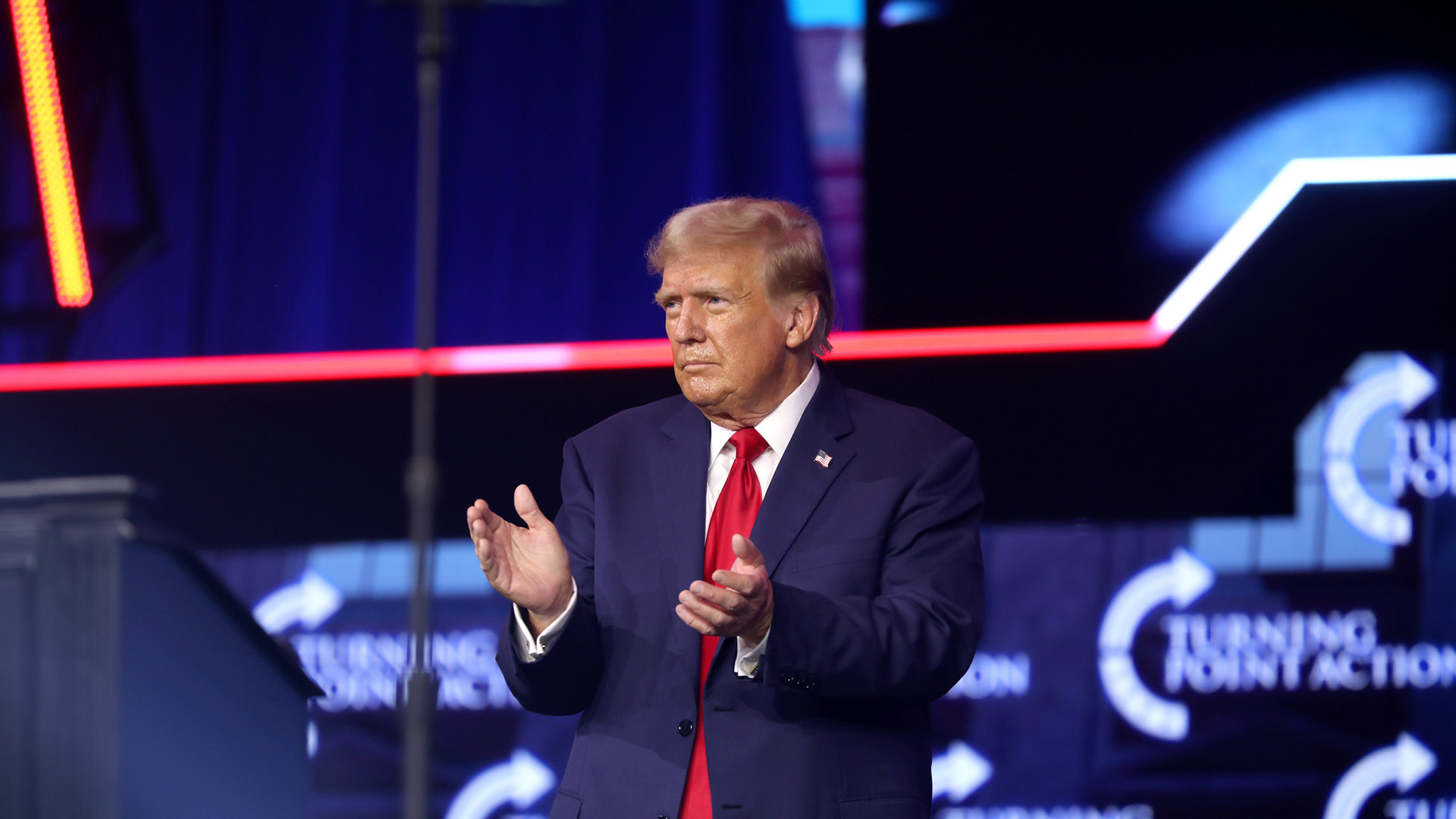Theme
The attempt to assassinate former President Donald Trump provided him with a temporary boost in momentum, but it was quickly overshadowed by President Joe Biden’s decision to step down from the presidential race and to launch Vice President Kamala Harris’s campaign to replace him on the Democratic ticket.
Summary
The attempted assassination of former President Trump and his defiant response strengthened his support within the Republican Party. He gained further media coverage and momentum after he selected J.D. Vance as his new running mate and the largely successful Republican National Convention. Eight days after the attack, the media coverage quickly shifted away from Trump and Vance to cover President Biden’s decision to abandon his campaign, Harris’s campaign launch and the surprisingly rapid coalescence of the Democratic Party to support her candidacy. Some observers initially predicted the assassination attempt and Trump’s media-savvy response would deliver him the White House in November, but the race quickly tightened as voters’ attention shifted away from the attack and enthusiasm for Harris soared.
Analysis
1. Introduction
The US presidential campaign experienced a tumultuous period from late June to early August. There was an attempted assassination of a former president and current presidential candidate, a sudden departure of a president seeking re-election, and the quick and meteoric rise of a previously underperforming vice president as a presidential candidate.
On 27 June, President Biden and former President Trump participated in their first (and only) debate. Biden had a disastrous night as he struggled to communicate his views. This increased pressure to quickly show voters he could beat Trump and serve an additional four years or bow out and let another Democratic candidate lead the ticket. Over the next few weeks, Biden’s increased media and public appearances did little to address those concerns. In fact, for many Democrats, it confirmed their fears about the president’s advanced age.
Then, at a campaign rally in Butler, Pennsylvania, on 13 July, former President Trump narrowly escaped an assassination attempt. A bullet grazed his right ear while he was speaking to an audience before the US Secret Service neutralised the threat. Minutes later, Trump, ever the showman, stood up and shook his fist defiantly with lines of blood streaked across his face. He yelled, ‘Fight! Fight! Fight!’ before he was ushered off stage.
Two days later, on 15 July, Trump named J.D. Vance, a younger Republican Senator from Ohio, his running mate at the beginning of the Republican National Convention in Milwaukee, Wisconsin. Delegates overwhelmingly endorsed Vance. Trump appeared throughout the convention with a bandage on his ear as his supporters cheered him on. Trump and the Republican Party ended the four-day convention soaring, riding high after a week of generally strong media coverage.
Then, on 21 July, President Biden relented to growing pressure from the Democratic Party to drop out of the presidential race. He announced his decision by publishing a letter online and then endorsing his vice president, Kamala Harris.
Within a few weeks of Biden dropping out, Harris re-energised disaffected Democratic voters, united the party behind her campaign, raised significant sums of money, selected Minnesota Governor Tim Walz as her vice-presidential running mate and eliminated Trump’s lead in national polling.
2. Preliminary impact of the assassination attempt
2.1. Images of a defiant Trump contrast with Biden’s abysmal presidential debate performance
Trump’s instincts, once he realised that he survived the assassination attempt, to stand up, pump his fist and yell to his supporters resulted in iconic images. They showed a strong, defiant candidate that bolstered his campaign narrative that he is a strong, macho candidate who will not back down.
This visual stood in stark contrast to Biden, whose age and mental acuity had been called into question, particularly after his disastrous debate performance on 27 June.
2.2. Increased enthusiasm and support for Trump
The assassination attempt on Trump and his response likely solidified his standing with his base. In a 29 June-2 July Wall Street Journal poll, 70% of Trump supporters were enthusiastic about his candidacy. By 25 July, the total jumped to 85%.
Before the attack, Trump already had a messiah-like status with many of his supporters. The fact that he narrowly escaped death in a campaign event likely further cemented this view among some of his supporters. In a 16 July Reuters/Ipsos poll, one-third of respondents said he survived the attack by divine providence.
His standing with voters outside of his core base also improved. In a 23-25 July Wall Street Journal poll, Trump’s favourable to unfavourable rating was 47% to 50%, a four-point bump since 2 July and his highest total since the Wall Street Journal started asking voters in November 2021.
However, it is not clear if voters’ opinions of Trump shifted because of the assassination attempt, his selection of Vance as his running mate, the Republican National Convention or some combination of these factors, as all three events took place within one week.
2.3. Amplification and strengthening of Trump’s narrative of persecution and grievance
The attempt on Trump’s life provided additional fuel to his argument –which he uses in campaign rallies and social media posts– that he is the victim of attacks by ‘enemies’ or Democrats.
Since Trump narrowly lost his re-election bid in 2020, he has presented himself as the target of the Biden Administration, making unfounded claims of ‘electoral interference’, painting all the legal cases launched against him as political persecution and even advancing the narrative that the 2022 Federal Bureau of Investigations (FBI) raid on his Mar-a-Lago residence to retrieve classified documents was a government attempt to assassinate him.
One of his common refrains on the campaign trail is, ‘They’re not really after me; they’re after you. I’m just in the way’. The assassination attempt seemed to validate Trump’s claim, particularly because one supporter was killed, and others were injured. If the government were to uncover evidence that the shooter was linked to the Democratic Party or left-leaning organisations, this would further amplify and strengthen Trump’s claims.
2.4. Perception of a greater chance for Trump to win the White House
Some analysts predicted that Trump’s survival and response to the assassination attempt would help win him the White House in November. He was facing a rival in Biden, who had even lower favourability ratings, was having difficulty energising his base, had a narrow path to victory and was a few weeks away from a poor debate performance. At a time when Biden was trying to underscore the dangers of electing Trump, Biden was having difficulty communicating his message and was being heavily scrutinised by the media, Democratic Party officials and voters every time he appeared publicly, leading to intense analysis of every misstatement or misstep.
2.5. A brief distraction for Biden from the talk about his advanced age
The shooting temporarily shifted the public’s attention away from the intense scrutiny of President Biden’s age and fitness.
His response to the shooting –including speaking with Trump– allowed him to look presidential and serve as the ‘consoler-in-chief’. Biden delivered a short speech from the Oval Office urging Americans to ‘lower the temperature in our politics’.
Less than a week after the shooting, though, more Democratic leaders resumed calling on him to resign, and Democratic members of Congress rebuffed a proposal to nominate Biden before the 19-22 August Democratic National Convention in Chicago, Illinois.
3. The impact since Biden’s decision to step down and endorse Harris
3.1. Assassination attempt currently overshadowed
President Biden’s 21 July decision to drop out of the 2024 race and endorse Vice President Harris upended the presidential race and drastically shifted the media coverage towards the Democrats.
The investigation continues into the attacker and the failures of the president’s security protection, and the Secret Service and FBI have been called to Capitol Hill to testify about the attacks. However, the media has shifted the focus on to Harris and the launch of her presidential campaign, disrupting Trump’s late June/early July momentum.
3.2. The race tightens
On 1 July an aggregate of national general election polls showed Trump had a three-point lead over Harris (43.8% to 40.8%). On 17 August these national polls showed Harris ahead of Trump by more than two points (46.7% to 44.4%), a five-point swing in less than two months.
This was a surprising development. Before entering the race, she was viewed unfavourably by a majority of voters and brought political baggage from her time as vice president and her unsuccessful 2020 presidential campaign. Since entering the race she has benefited from favourable media coverage, a rainfall in financial contributions and an outpouring of support from voters desperately seeking an alternative to the two older, disliked candidates.
Harris has started to build a more traditional Democratic coalition by making inroads with disenchanted Democratic constituencies, such as younger voters, Black voters, Latino voters and other reliable Democratic sympathisers. A 24 July New York Times/Siena College poll indicated Harris already has more support among young voters and voters of colour than Biden while maintaining support from older and white voters.
Biden likely needed to win the Rust Belt states of Michigan, Pennsylvania and Wisconsin by relying on older, white voters to win the 2024 election. In these three battleground states a 28 April-9 May New York Times/Siena College poll showed Biden tied with Trump in Michigan and Wisconsin and slightly trailing Trump in Pennsylvania. Three months later, a 5-9 August New York Times/Siena College poll showed Harris leading Trump by four points in these three states (50% to 46%).
Polls also now show that Harris has opened more paths to reach the requisite 270 votes in the Electoral College to win the White House. As Harris has more robust support from minority voters, she hopes to expand the map by opening additional states to compete. An 8-15 August New York Times/Siena College poll revealed that among likely voters, Harris leads Trump by five points (50% to 45%) in Arizona and narrowed his lead in Georgia (50% to 46%) and Nevada (48% to 47%). This is a notable development as Trump was beating Biden 50% to 41% in Arizona, Georgia and Nevada in the 28 April-9 May New York Times/Siena College poll. The map expansion will likely force the Trump campaign to expend time campaigning and resources in states it previously was on track to win.
3.3. Enthusiasm gap between parties nearly closed
Democratic voters’ enthusiasm has grown significantly since Biden dropped out of the race. Comparing the 2 and 25 July Wall Street Journal polls, the enthusiasm gap is now only 4%, compared with 33% just a few weeks ago.
Moreover, according to a 26-27 July ABC News/Ipsos poll, 76% of Democrats now say they are ‘absolutely certain to vote’ in the November election. This is a 6% increase since Biden withdrew from the race.
4. Political violence in the US
4.1. Citizen concerns
The shooting has sparked fears of more acts of political violence. Political leaders, including Biden and Trump, issued statements soon after the attack to urge citizens to tone down the heated rhetoric to reduce tensions and decrease the possibility of further actions.
Polling after the assassination attempt showed that Americans were troubled about potential future acts of violence. The 16 July Reuters/Ipsos poll revealed that 86% of Americans were concerned that ‘acts of violence would throw the country into chaos’.
Although the shooter was a registered Republican and the FBI has yet to uncover a motive for the attack, 78% of Americans believe political polarisation played at least a moderate role in the assassination attempt, according to a 25-29 July AP/NORC poll.
4.2. The US government’s response
The FBI and the Department of Homeland Security issued a joint intelligence bulletin on 15 July, which noted they ‘remain concerned about the potential for follow-on or retaliatory acts of violence following this attack’. The bulletin also stated that ‘individuals in some online communities have threatened, encouraged, or referenced acts of violence in response to the attempted assassination’.
The potential risks are not limited to acts by US voters. On 6 August the Department of Justice announced it had arrested a Pakistani national for recruiting individuals to assassinate US government officials. Investigators believed Iran was directing him to target high-ranking individuals across the political spectrum, including former President Trump. The US government has not found evidence connecting the Pakistani national to the 13 July assassination attempt.
4.3. A history of political violence in the US
The US has a long history of political violence. In the country’s nearly 250-year history there have been four presidential assassinations and six attempts. There have also been many assassination attempts against presidential candidates and US officials. The most recent attack took place in 2017 when a gunman shot Steve Scalise, a Republican leader in the House of Representatives, and three other individuals in what the FBI later called an act of domestic terrorism.
Some have compared the year 2024 to 1968, when two high-profile US political leaders were assassinated: civil rights leader Martin Luther King, Jr. in April and Democrat presidential candidate Robert F. Kennedy in June. The killing of two young, inspiring leaders in such a short period shocked the US.
There are some clear differences between then and now. Kennedy and King died in 1968, while Trump survived the attack on his life with a minor wound. The US was also deeply divided on the US involvement in the Vietnam War in 1968, where over 500,000 US troops were fighting. Today, although many Americans are closely following the Russia-Ukraine war and the Israel-Hamas war, and there have been some protests in response to US support for Israel, the US government is not seeking to enter either conflict. Lastly, Americans in 1968 were very concerned about a Soviet Union nuclear attack on US soil. The US faces many threats today, but nothing that currently rises to the level of a looming nuclear attack.
However, 2024 does have a few things in common with 1968: the US is divided; the country is experiencing intensified political rhetoric; the attacks took place during a presidential election year; and there is a growing unease about the current global conflicts.
Conclusions
Even before Biden dropped out of the presidential race and Harris’ popularity soared, the assassination attempt on Trump was unlikely to change its trajectory drastically.
Biden and Trump remained statistically tied through most of 2024 despite the four criminal cases against Trump and voter concerns about Biden’s age. For example, according to NBC’s 7-9 July poll, Biden only trailed Trump by 2% even though 65% of voters expressed ‘major concerns’ about Biden’s physical and mental health, and 33% were satisfied with Biden as the nominee.
Unlike former President Ronald Reagan, who was hospitalised and nearly died in March 1981, Trump luckily suffered minor injuries to his ear. It, therefore, makes it easier for voters, particularly those who do not support Trump, to move on from the attack.
Despite Trump’s immediate calls to tone down the rhetoric after the failed assassination attempt, he has not tried to unify the country or generate much sympathy for himself. Instead, he returned quickly to his usual attack mode. During his 18 July Republican National Convention speech he sought to promote unity and vowed to serve as president ‘for all of America’. However, he deviated from his prepared remarks and accused the Democrats of ‘cheating’ in the 2020 election and complained of an immigrant ‘invasion’, amongst other of his common stump speech topics. At a 15 August press conference he justified his attacks on Harris by saying, ‘I think I’m entitled to personal attacks. I don’t have a lot of respect for her’. He added, ‘They want me to be nice. But they’re not being nice to me’.
The length of time voters will be sympathetic to a presidential candidate who is a victim of an attack is likely shorter because the election is less than four months away. Democratic partisans are not expected to extend Trump much sympathy given their disdain for him and the limited time to persuade voters before election day.
Lastly, history shows sympathy for elected leaders or candidates who survive an assassination attempt that only lasts so long. When Reagan was shot, his approval rating jumped from 60% to 68%. However, as the economy soured, his approval rating dropped to 49% nine months later.



